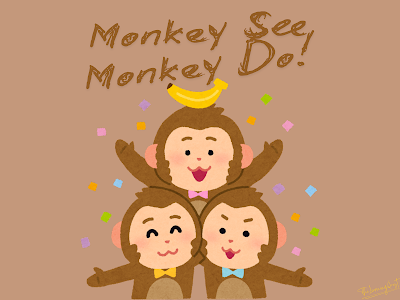Did you know that in 1960, some scientists decided to experiment on 5 monkeys? They were kept in a cage, probably thinking it was just another day in the monkey business. But little did they know... the experiment was about to begin.
In the center of their new cage the researchers put a
shiny ladder, and at the top of the ladder is a bunch of bananas. A brave
monkey decides to make his move. He took a step up the stairs, his mouth
watering at the thought of that sweet banana. But just as he's about to reach
the top, BAM! Scientists unleash a blast of water ice on all the monkeys
below.
Then another monkey, perhaps less cautious and still
hopeful, tries his luck on the ladder. Same result. More ice water, more
painful monkeys. Pretty soon, whenever one monkey even thinks about the stairs,
the others nudge him back and ask him, "What were you thinking? Death
Wish?” Climbing the ladder = chill disaster for everyone. No more
climbing stairs.
But wait! Now things get interesting. The scientists swap
one of the original monkeys with a newcomer fresh and naive. Larry sees the
bananas and obviously decides to go for them. But, surprise, he barely takes a
step before the other monkeys pounce on him, pulling him back and saying
something like, "Oh, no, buddy, we don't do that here." Lesson
learned. No banana, no climbing ladder, no question.
Over time, one by one, each original monkey is replaced
with a new face. Every newbie tries to climb, and every newbie is
"educated" by the experienced gang with some tough love. In the end,
the cage is filled with five monkeys who have never climbed that ladder and
experienced the scientist's icy water. And yet, if you dare to reach the
ladder, you will still be pulled by others—No ladder-climbing allowed. Why?
Nobody knows! Things are just like that.
If we could talk monkeys, and if we asked them,
"Hey, why can't you climb the stairs?" They'll probably shrug and
say, "I don’t know! It's just… always been this way."
And thus, the 5 monkeys experiment gave us a perfect example of how sometimes even we humans just follow the "rules" without knowing why. So, the next time you're told "it's the way we've always done it," remind them of the 5 monkeys. They are there too, scratching their heads, asking, "But... why?"
The 5-Monkey Experiment is a great metaphor for many
workplace traditions. In organizations, habits or rules often persist long
after their purpose is forgotten. Think of a company policy no one can explain
or a process done just because. These routines become ingrained,
creating a cycle where people follow along without asking why. It’s a reminder
to revisit old habits and see if they truly benefit the team today.
These routines are often followed because it feels safer
to do what everyone else is doing. This group think is driven by social
proof (we trust what others do), a natural fear of change, and even an urge to
avoid rocking the boat. In workplaces, we often sticking with the safe
traditions. This pattern shows why we need to consciously ask, “Does this still make sense?” rather than just
following the crowd.
Blindly following tradition in organizations can really hold
us back. By clinging to the past, organizations risk missing out on new
ideas and opportunities. It's important to regularly reevaluate our practices
and ask, "Is this still working for us?"
Avoid getting stuck in a rut.
Breaking free
from outdated traditions can transform an organization. Leaders should
encourage a culture of inquiry, where one should ask "Why do we do this?" is welcomed rather
than frowned upon. Creating safe spaces for employees to voice their
ideas can foster innovation and new perspectives. When teams feel comfortable
challenging the status quo, they are more likely to suggest improvements that
drive growth. Embracing change not only accelerates creativity but also keeps
the organization relevant in a fast-paced world. By being open to new ways
of thinking, companies can improve and adapt, ensuring they are not stuck
in the past.
To break free from the "Monkey See, Monkey Do!"
mentality in the workplace, start by encouraging your team to ask, "Why do we do this?"
It's a simple question, but it can spark meaningful conversations. Consider
holding regular "why" meetings, where everyone can reevaluate
current practices and share ideas. These sessions can create a safe space for
open conversation, helping your team identify outdated habits that may be
slowing them down. Small changes, such as questioning routine processes, can
lead to big improvements and a more innovative mindset. Remember, being curious
keeps the workplace fresh and adaptable!
Understanding why we do what we do is key to making
meaningful changes both personally and in our organizations. When we feel free
to ask questions and challenge the status quo, it opens the door to innovation
and growth. This curiosity leads to the discovery of better ways of working and
connecting with each other. Instead of just going through the motions, we can
create a culture where everyone feels empowered to contribute ideas. Embracing
this mindset not only boosts morale but also drives positive change, making our
workplaces more dynamic and responsive to new challenges. Let's choose
purposeful action over blind tradition!













0 Comments